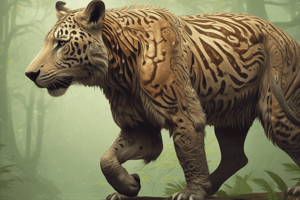Podcast
Questions and Answers
Which characteristic distinguishes Animalia from Porifera and Cnidaria?
Which characteristic distinguishes Animalia from Porifera and Cnidaria?
- Ability to move and respond to stimuli
- Bilateral symmetry
- Heterotrophic nutrition
- True tissues (correct)
What is the primary mode of nutrition for animals?
What is the primary mode of nutrition for animals?
- Detritivory
- Heterotrophy (correct)
- Omnivory
- Autotrophy
During embryonic development, what stage comes after the blastula?
During embryonic development, what stage comes after the blastula?
- Fetus
- Gastrula (correct)
- Organogenesis
- Zygote
What reproductive strategy is used by some invertebrates, such as starfish?
What reproductive strategy is used by some invertebrates, such as starfish?
Approximately how many phyla (major groups) are estimated to exist in the kingdom Animalia?
Approximately how many phyla (major groups) are estimated to exist in the kingdom Animalia?
Where can animals be found on Earth?
Where can animals be found on Earth?
Study Notes
Characteristics
- Multicellular, eukaryotic organisms
- Heterotrophic (obtain energy by consuming other organisms or organic matter)
- Lack cell walls
- Ability to move and respond to stimuli
Body Structure
- Bilateral symmetry (body can be divided into left and right halves)
- True tissues (distinguishes Animalia from Porifera and Cnidaria)
- Body cavities (coelom) present in most animals
Nutrition
- Obtain energy by consuming other organisms or organic matter
- Heterotrophic, meaning they cannot produce their own food
- Modes of nutrition:
- Herbivory (plant-eating)
- Carnivory (meat-eating)
- Omnivory (eating both plants and animals)
- Detritivory (eating dead organic matter)
- Parasitism (living on or inside another organism)
Development and Reproduction
- Embryonic development: zygote → blastula → gastrula → organogenesis
- Reproductive strategies:
- Sexual reproduction (most animals)
- Asexual reproduction (some invertebrates, e.g., starfish)
- Hermaphroditism (some animals, e.g., earthworms)
Diversity
- Estimated 30-40 phyla (major groups)
- Range from simple, single-celled organisms to complex, multicellular organisms
- Found in almost every environment on Earth, from deserts to deep-sea vents
Characteristics of Animals
- Multicellular, eukaryotic organisms
- Heterotrophic, obtaining energy by consuming other organisms or organic matter
- Lack cell walls
- Ability to move and respond to stimuli
Body Structure
- Bilateral symmetry, allowing body division into left and right halves
- True tissues, distinguishing Animalia from Porifera and Cnidaria
- Presence of body cavities (coelom) in most animals
Nutrition and Energy
- Obtain energy by consuming other organisms or organic matter
- Heterotrophic, unable to produce own food
- Modes of nutrition include:
- Herbivory (plant-eating)
- Carnivory (meat-eating)
- Omnivory (eating both plants and animals)
- Detritivory (eating dead organic matter)
- Parasitism (living on or inside another organism)
Development and Reproduction
- Embryonic development: zygote → blastula → gastrula → organogenesis
- Reproductive strategies:
- Sexual reproduction (most animals)
- Asexual reproduction (some invertebrates, e.g., starfish)
- Hermaphroditism (some animals, e.g., earthworms)
Animal Diversity
- Estimated 30-40 phyla (major groups)
- Range from simple, single-celled organisms to complex, multicellular organisms
- Found in almost every environment on Earth, from deserts to deep-sea vents
Studying That Suits You
Use AI to generate personalized quizzes and flashcards to suit your learning preferences.
Description
This quiz covers the characteristics of multicellular, eukaryotic organisms, including their body structure and nutrition habits. Learn about the unique features that distinguish animals from other kingdoms.




